
Exhibition time: 17-19 March, 2026 Shanghai, China
 中文
中文

Exhibition time: 17-19 March, 2026 Shanghai, China
 中文
中文
Soil microorganisms exist in large numbers in the soil as long as there is a carbon source for energy. A large number of bacteria in the soil exists, but because of their small size, they have a smaller biomass. Actinomycetes are a factor of 10 times smaller in number but are larger in size so they are similar in biomass to bacteria. Fungus population numbers are smaller but they dominate the soil biomass when the soil is not disturbed. Bacteria, actinomycetes, and protozoa are hardy and can tolerate more soil disturbance than fungal populations so they dominate in tilled soils while fungal and nematode populations tend to dominate in untilled or no-till soils.
There are more microbes in a teaspoon of soil than there are people on the earth. Soils contain about 8 to 15 tons of bacteria, fungi, protozoa, nematodes, earthworms, and arthropods. See fact sheets on Roles of Soil Bacteria, Fungus, Protozoa, and Nematodes.
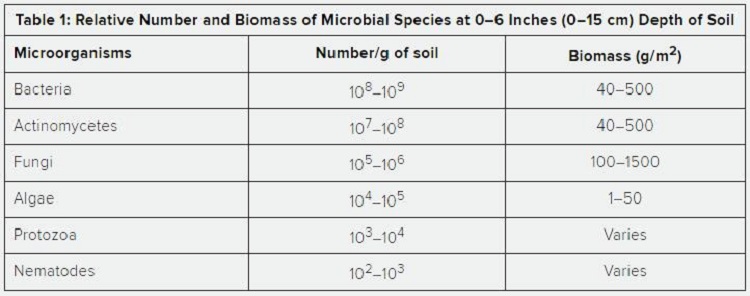
Microbial Soil Organic Matter Decomposition
Organic matter decomposition serves two functions for the microorganisms, providing energy for growth and suppling carbon for the formation of new cells. Soil organic matter (SOM) is composed of the "living" (microorganisms), the "dead" (fresh residues), and the "very dead" (humus) fractions. The "very dead" or humus is the long-term SOM fraction that is thousands of years old and is resistant to decomposition. Soil organic matter has two components called the active (35 percent) and the passive (65 percent) SOM. Active SOM is composed of the "living" and "dead" fresh plant or animal material which is food for microbes and is composed of easily digested sugars and proteins. The passive SOM is resistant to decomposition by microbes and is higher in lignin.
Microbes need regular supplies of active SOM in the soil to survive in the soil. Long-term no-tilled soils have significantly greater levels of microbes, more active carbon, more SOM, and more stored carbon than conventional tilled soils. A majority of the microbes in the soil exist under starvation conditions and thus they tend to be in a dormant state, especially in tilled soils.
Dead plant residues and plant nutrients become food for the microbes in the soil. Soil organic matter (SOM) is basically all the organic substances (anything with carbon) in the soil, both living and dead. SOM includes plants, blue green algae, microorganisms (bacteria, fungi, protozoa, nematodes, beetles, springtails, etc.) and the fresh and decomposing organic matter from plants, animals, and microorganisms.
Soil organic matter can be broken down into its component parts. One hundred grams (g) or 100 pounds (lbs) of dead plant material yields about 60–80 g (lbs) of carbon dioxide, which is released into the atmosphere. The remaining 20–40 g (lbs) of energy and nutrients is decomposed and turned into about 3–8 g (lbs) of microorganisms (the living), 3–8 g (lbs) of non-humic compounds (the dead), and 10–30 g (lbs) of humus (the very dead matter, resistant to decomposition). The molecular structure of SOM is mainly carbon and oxygen with some hydrogen and nitrogen and small amounts of phosphorus and sulfur. Soil organic matter is a by-product of the carbon and nitrogen cycles.
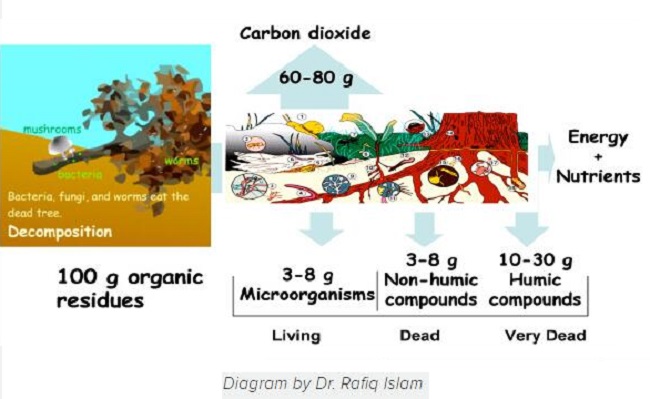
Soil Organic Matter Nutrients
The nutrients in the soil have a current value of $680 for each 1 percent SOM or $68 per ton of SOM based on economic values for commercial fertilizer (see Table 2). SOM is composed of mostly carbon but associated with the carbon is high amounts of nitrogen and sulfur from proteins, phosphorus, and potassium. SOM should be considered like an investment in a certificate of deposit (CD). Soils that are biologically active and have higher amounts of active carbon recycle and release more nutrients for plant growth than soils that are biologically inactive and contain less active organic matter. Under no-till conditions, small amounts of nutrients are released annually (like interest on a CD) to provide nutrients slowly and efficiently to plant roots. However, with tillage, large amounts of nutrients can be released since the SOM is consumed and destroyed by the microbes. Since SOM levels are slow to build, the storage capacity for nutrients is decreased and excess nutrients released are often leached to surface waters. SOM is a storehouse for many plant nutrients.
Consider the following three scenarios. Soils typically turnover 1 to 3 percent of their nitrogen stored in SOM. Tilled or unhealthy soils release a lower percent of nitrogen due to lower microbial activity. A tilled soil with 2 percent SOM (2,000 lbs of N) may release 1 percent N or 20 lbs of N per year. A soil that is more biologically active and has 4 percent SOM (4,000 lbs N) may release 1.5 percent N or 60 lbs N while a 6 percent SOM soil (6,000 lbs N) may release 2 percent N or 120 lbs of N. In tilled soils, excess nutrients released are often lost and the carbon stores are depleted so that future storage of nutrients is reduced. Farmers often see this occur when they till a virgin soil, an old pasture, or a fence row. For several years, crops on the newly tilled soil will grow better than the surrounding soils, but over time the soil will be depleted of carbon and the newly tilled soil will become less fertile because the carbon is oxidized as carbon dioxide and lost to the atmosphere. Tillage results in the oxidation and destruction of carbon in the soil by increasing the soil oxygen levels, thereby promoting bacteria populations to expand and consume active carbon in the soil.
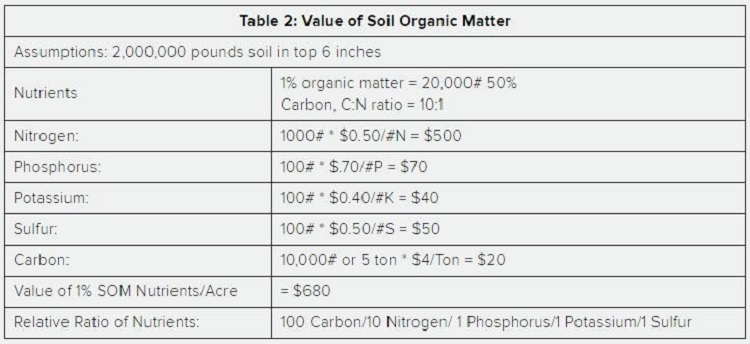
Climate, Temperature, and pH Effects on SOM
SOM is affected by climate and temperature. Microbial populations double with every 10 degree Fahrenheit change in temperature. If we compare the tropics to colder arctic regions, we find most of the carbon is tied up in trees and vegetation above ground. In the tropics, the topsoil has very little SOM because high temperatures and moisture quickly decompose SOM. Moving north or south from the equator, SOM increases in the soil. The tundra near the Arctic Circle has a large amount of SOM because of cold temperatures. Freezing temperatures change the soil so that more SOM is decomposed then in soils not subject to freezing.
Moisture, pH, soil depth, and particle size affect SOM decomposition. Hot, humid regions store less organic carbon in the soil than dry, cold regions due to increased microbial decomposition. The rate of SOM decomposition increases when the soil is exposed to cycles of drying and wetting compared to soils that are continuously wet or dry. Other factors being equal, soils that are neutral to slightly alkaline in pH decompose SOM quicker than acid soils; therefore, liming the soil enhances SOM decomposition and carbon dioxide evolution. Decomposition is also greatest near the soil surface where the highest concentration of plant residues occur. At greater depths there is less SOM decomposition, which parallels a drop in organic carbon levels due to less plant residues. Small particle sizes are more readily degraded by soil microbes than large particles because the overall surface area is larger with small particles so that the microbes can attack the residue.
A difference in soil formation also occurs traveling east to west across the United States. In the east, hardwood forests dominated and tree tap roots were high in lignin, and deciduous trees left large amounts of leaf litter on the soil surface. Hardwood tree roots do not turn over quickly so organic matter levels in the subsoil are fairly low. In forest soils, most of the SOM is distributed in the top few inches. As you move west, tall grassland prairies dominated the landscape and topsoil formed from deep fibrous grass root systems. Fifty percent of a grass root dies and is replaced every year and grass roots are high in sugars and protein (higher active organic matter) and lower in lignin. So soils that formed under tall grass prairies are high in SOM throughout the soil profile. These prime soils are highly productive because they have higher percentage of SOM (especially active carbon), hold more nutrients, contain more microbes, and have better soil structure due to larger fungal populations.
Carbon to Nitrogen Ratio
The break down of organic residues by microbes is dependent upon the carbon to nitrogen (C:N) ratio. Microbes in a cow's rumen, a compost pile, and soil microbes rely on the C:N ratio to break down organic (carbon-based) residues. Consider two separate feed sources, a young tender alfalfa plant and oat or wheat straw. A young alfalfa plant has more crude protein, amino acids, and sugars in the stalk so it is easily digested by microbes whether it is in a cow's rumen, a compost pile, or in the soil. Young alfalfa has a high nitrogen content from protein (amino acids and proteins are high in nitrogen and sulfur), so it has a lower carbon to nitrogen ratio (less carbon, more nitrogen). However, oat and wheat straw (or older mature hay) has more lignin (which is resistant to microbial decomposition), lower crude protein, and less sugars in the stalk and a higher C:N ratio. Straw is decomposed by microbes but it takes additional time and nitrogen to break down this high carbon source.
A low nitrogen content or a wide C:N ratio is associated with slow SOM decay. Immature or young plants have a higher nitrogen content, lower C:N ratios and faster SOM decay. For good composting, a C:N ratio less than 20 allows the organic materials to decompose quickly (4 to 8 weeks) while a C:N ratio greater than 20 requires additional N and slows down decomposition. So if we add a high C based material with low N content to the soil, the microbes will tie up soil nitrogen. Eventually, the soil N is released but in the short-term the N is tied up. The conversion factor for converting N to crude protein is 16.7, which relates back to why it is so important to have a C:N ratio of less than 20.
The C:N ratio of most soils is around 10:1 indicating that N is available to the plant. The C:N ratio of most plant residues tends to decrease with time as the SOM decays. This results from the gaseous loss of carbon dioxide. Therefore, the percentage of nitrogen in the residual SOM rises as decomposition progresses. The 10:1 C:N ratio of most soils reflects an equilibrium value associated with most soil microbes (Bacteria 3:1 to 10:1, Fungus 10:1 C:N ratio).
Bacteria are the first microbes to digest new organic plant and animal residues in the soil. Bacteria typically can reproduce in 30 minutes and have high N content in their cells (3 to 10 carbon atoms to 1 nitrogen atom or 10 to 30 percent nitrogen). Under the right conditions of heat, moisture, and a food source, they can reproduce very quickly. Bacteria are generally less efficient at converting organic carbon to new cells. Aerobic bacteria assimilate about 5 to 10 percent of the carbon while anaerobic bacteria only assimilate 2 to 5 percent, leaving behind many waste carbon compounds and inefficiently using energy stored in the SOM.
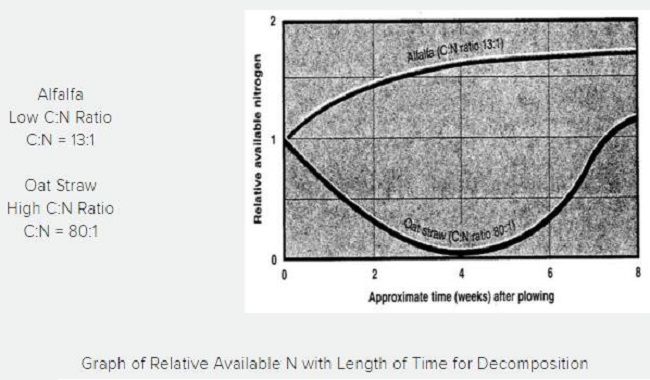
Fungus generally release less carbon dioxide into the atmosphere and are more efficient at converting carbon to form new cells. The fungus generally captures more energy from the SOM as they decompose it, assimilating 40 to 55 percent of the carbon. Most fungi consume organic matter higher in cellulose and lignin, which is slower and tougher to decompose. The lignin content of most plant residues may be of greater importance in predicting decomposition velocity than the C:N ratio.
Mycorrhizal fungi live in the soil on the surface of or within plant roots. The fungi have a large surface area and help in the transport of mineral nutrients and water to the plants. The fungus life cycle is more complex and longer than bacteria. Fungi are not as hardy as bacteria, requiring a more constant source of food. Fungi population levels tend to decline with conventional tillage. Fungi have a higher carbon to nitrogen ratio (10:1 carbon to nitrogen or 10 percent nitrogen) but are more efficient at converting carbon to soil organic matter. With high C:N organic residues, bacteria and fungus take nitrogen out of the soil (see the graph on net immobilization).
Protozoa and nematodes consume other microbes. Protozoa can reproduce in six to eight hours while nematodes take from three days to three years with an average of 30 days to reproduce. After the protozoa and nematodes consume the bacteria or other microbes (which are high in nitrogen), they release nitrogen in the form of ammonium (see the graph on net mineralization). Ammonium (NH4+) and nitrates (NO3-) are easily converted back and forth in the soil. Plants absorb ammonium and soil nitrates for food with the help of the fungi mycorrhizal network.
Microorganism populations change rapidly in the soil as SOM products are added, consumed, and recycled. The amount, the type, and availability of the organic matter will determine the microbial population and how it evolves. Each individual organism (bacteria, fungus, protozoa) has certain enzymes and complex chemical reactions that help that organism assimilate carbon. As waste products are generated and the original organic residues are decomposed, new microorganisms may take over, feeding on the waste products, the new flourishing microbial community (generally bacteria), or the more resistant SOM. The early decomposers generally attack the easily digested sugars and proteins followed by microorganisms that attack the more resistant residues.
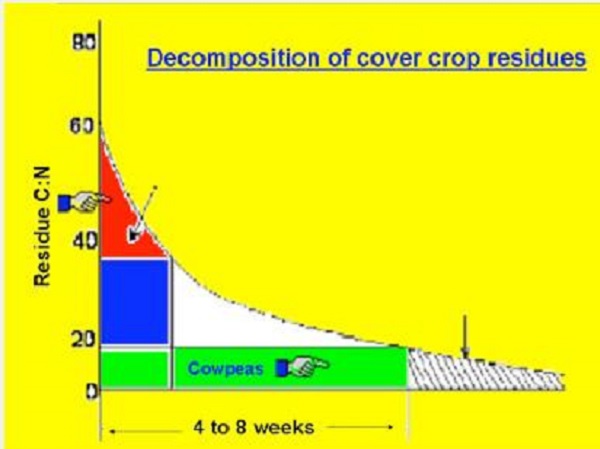
Decomposition of Cover Crop Residues: Cowpeas with a low C:N ratio (<20) will="" decompose="" in="" four="" to="" eight="" weeks="" and="" result="" net="" mineralization="" or="" release="" of="" n.="" sudan="" grass="" cereal="" rye="" with="" a="" higher="" c:n="" ratio="">38) will decompose slowly (three months to one year or more) and will result in net immobilization or will tie up soil N. Graph by Dr. Rafiq Islam.

Graph of Cowpeas (C:N<20) being decomposed by bacteria and fungus, the carbon dioxide evolution and protozoa and nematodes consuming the bacteria and fungus and excreting ammonium into the soil for plant growth. NO3- and NH4+ are easily converted in the soil. Graph by Dr. Rafiq Islam.
Cover crops supply food (active carbon like glucose and proteins) to the microbes to feed on. In the soil, there are 1,000 to 2,000 times more microbes associated with roots than are living in bare or tilled soil. The microbes in turn build SOM and store soil nutrients. Building SOM requires soil nutrients like N-P-K-S to be tied up in the soil. Winter cover crops soak up excess soil nutrients and supply food to all the microbes in the soil during the winter months rather than microbes having to use up SOM reserves for nutrients. In a conventional tilled field, soil nutrients are quickly released as SOM is burned up and the microbes and soil organisms habitat are destroyed. In a no-till field, high levels of SOM are reserves of soil nutrients which are slowly released into the soils. Adding a living cover crop to a no-till field increases active organic matter (sugars and proteins) for the soil microbes. Soil microbes have two crops to feed on instead of one crop per year. Microbes thrive under no-till conditions and winter cover crops. Cover crops and manure can be used to feed soil microbes and recycle soil nutrients. As soil microbes decompose organic residues, they slowly release nutrients back into the soil for the winter cover crops or for the preceding crop. Cover crops prevent the nutrients from being lost through soil erosion, leaching, volatilization, or denitrification.
Summary
Microorganisms abound in the soil and are critical to decomposing organic residues and recycling soil nutrients. Bacteria are the smallest and most hardy microbe in the soil and can survive under harsh conditions like tillage. Bacteria are only 20 to 30 percent efficient at recycling carbon, have a high nitrogen content (3 to 10 carbon atoms to 1 nitrogen atom or 10 to 30 percent nitrogen), a lower carbon content, and a short life span. Carbon use efficiency is 40 to 55 percent for mycorrhizal fungi so they store and recycle more carbon (10:1 carbon to nitrogen ratio) and less nitrogen (10 percent) in their cells than bacteria. Fungi are more specialized but need a constant food source and grow better under no-till conditions.
Soil organic matter (SOM) is composed of the "living" (microorganisms), the "dead" (fresh residues), and the "very dead" (humus) fractions. Active SOM is composed of the fresh plant or animal material which is food for microbes and is composed of easily digested sugars and proteins. The passive SOM is resistant to decomposition by microbes (higher in lignin). Active SOM improves soil structure and holds plant available nutrients. Every 1 percent SOM contains 1,000 pounds of nitrogen, 100 pounds of phosphorus, 100 pounds of potassium, and 100 pounds of sulfur along with other essential plant nutrients. Tillage destroys SOM by oxidizing the SOM, allowing bacteria and other microbes to quickly decompose organic residues. Higher temperatures and moisture increase the destruction of SOM by increasing microbial populations in the soil. Organic residues with a low carbon to nitrogen (C:N) ratio (less than 20) are easily decomposed and nutrients are quickly released (4 to 8 weeks), while organic residue with a high C:N ratio (greater than 20) decompose slowly and the microbes will tie up soil nitrogen to decompose the residues. Protozoa and nematodes consume other microbes in the soil and release the nitrogen as ammonium, which becomes available to other microorganisms or is absorbed by plant roots.
Acknowledgment
This fact sheet was produced in conjunction with the Midwest Cover Crops Council (MCCC).
References
Alexander, Martin. 1991. Introduction to Soil Microbiology, 2nd Edition. Malabar, FL: Krieger Publishing Company.
Ingham, E.L. Soil Biology, The Soil Biology Primer, Chapter 3–Chapter 6. Natural Resource Conservation Service. See nrcs.usda.gov/wps/portal/nrcs/main/soils/health/biology/.
Magdoff, F. and H. van Es. 2001. Building Soils for Better Crops, 2nd edition. Sustainable Agriculture Network. Beltsville, MD. sare.org/publications/soils.htm.
from James J. Hoorman, Cover Crops and Water Quality, Extension Educator, Ohio State University Extension
Rafiq Islam, Soil and Water Specialist, Ohio State University Extension, South Centers at Piketon
Form Ohio State University of James J. Hoorman, Cover Crops and Water Quality, Extension Educator, Ohio State University Extension Rafiq Islam, Soil and Water Specialist, Ohio State University Extension, South Centers at Piketon